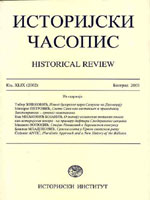Српски градови и тргови у угарској грађи из времена „Дуге војне“ (1443–1444)
Serbian Cities and Market Places in Hungarian Documentary Sources from the Time of the “Long Campaign” (1443–1444)
Author(s): Aleksandar KrstićSubject(s): History, Middle Ages, 15th Century
Published by: Istorijski institut, Beograd
Keywords: Wladislas I (III) Jagiello; Đurađ Branković; John Hunyadi; Belgrade; Bovan; Niš; Pirot; Prokuplje; Kruševac; Nekudim; Žabare
Summary/Abstract: This paper discusses the data on the cities, towns and market places at the territory of present day Serbia, which are preserved in the Hungarian documentary sources from the time of the “Long campaign”(1443–1444). Some of the cities were mentioned in the reports from the battlefield (like Belgrade and Niš), but the most of settlements were recorded as the places of issuing of charters and letters of King Wladislas I Jagiello, Voivode John Hunyadi and Cardinal Julian Cesarini (Belgrade, Bo/l/van, Niš, Pirot,Prokuplje, Kruševac). Although many of these data has been used in historiography for a long time, there are also some which have not been known, and some toponyms are incorrectly identified. Thus it was not known that the king of Hungary issued charters in Nekudim near Smedrevska Palanka and Žabar near Topola in January 1444. Nekudim was one of the residencies of the Serbian despots, and Žabar was also mentioned as the market place in the first Ottoman census book (defter) of the Smeredevo sancak in 1476/1477. In some historiographical works concerning the “Long campaign” it was wrongly considered that the king’s charter from Nekudim was issued in Jagodina in the Morava valley. Also, the author expressed his doubts that the toponym Szanock, recorded as the place of publication of one Polish charter of King Wladislas, refers to the village Šavac (medieval Šavče) in the valley of the Velika Morava, either to the village Šanac on the Zapadna Morava next to Kruševac, or any other place in Serbia. It is more likely that the document was issued by the royal chancery in the city of Sanok in Poland. New data concerning the charters of King Wladislas I issued in or near Belgrade, Niš and Kruševac, and which have not been known in the Serbian historiography, are also presented. At the same time, the author tried to correct some inaccuracies in the earlier literature related to certain events (for example, the analyses of the sources shows that the Hunyadi’s battle with the Ottomans from November 3, 1443, was nоt fought near the village Aleksinac, but took place in the vicinity of the city of Niš). The new data from the Hungarian documentary sources makes it possible to determine more accurately the direction and time of movement of the Crusader army at certain road sections in Serbia, both in its progression in the fall and early winter of 1443, and during its retreat in January 1444. This source material, though scarce, improves our knowledge of the Serbian cities, towns and market places in the late Middle Ages and of the network of medieval roads in the territory of Serbia. Also, considering the nomenclature of settlements used in the Hungarian sources of this period, the author tried to point out how the crusade leaders saw and perceived Serbian urban settlements through which they passed.
Journal: Историјски часопис
- Issue Year: 2016
- Issue No: 65
- Page Range: 113-146
- Page Count: 34
- Language: Serbian

